
Buying a shower cabin is an important decision that has a significant impact on the appearance and functionality of a bathroom. The right choice can transform the space into a home SPA or a functional relaxation zone. When planning bathroom equipment, it is worth considering what type of shower cabin will meet your expectations and fit the space available in the room. To help make the best decision, we present a comprehensive buying guide to make choosing the ideal shower cabin easier.
The best shower cabin — how to find it?
Wondering what shower cabin to buy? The choice isn't easy, especially since the "ideal cabin" should fit both the interior arrangement and meet our personal needs. What should you pay attention to before choosing a cabin?
- Dimensions and layout of the bathroom — the dimensions of the bathroom will define the maximum size of the cabin you can install. Pay attention to the layout of the space to ensure easy access to the shower.
- Style and decor — match the cabin to the style and decor of the bathroom. There are cabins to suit every style, from modern to traditional.
- Type of shower tray — the tray is the foundation of your shower cabin. Consider whether you prefer a shallow tray, which makes it easier to get in and out of the shower, or a deep one. You can also choose between acrylic, stone, ceramic trays, and modern composites.
- Budget — shower cabin costs vary significantly — it all depends on their type, materials used in production, and additional amenities.
Types of shower cabins
What is the best shower cabin? This question worries everyone planning a major or minor bathroom renovation in their apartment or house. It affects not only the convenience of use and the aesthetics of the space but also the functionality and durability of the entire room.
There are many types of shower cabins available on the market, differing in size, shape, door types, and materials. Often their choice and specification are determined by the available space and budget. If it's not to be a free-standing shower cabin (only in a large bathroom) but one that uses the bathroom walls, we have quite a few options:
- semi-circular shower cabins,
- square shower cabins,
- rectangular shower cabins,
- walk-in shower cabins,
Each model is made slightly differently, significantly affecting the cabin's functionality. Therefore, it is worth getting to know the specifics of each type. Below we present the characteristics of different types of cabins and recommended models.
Square shower cabin
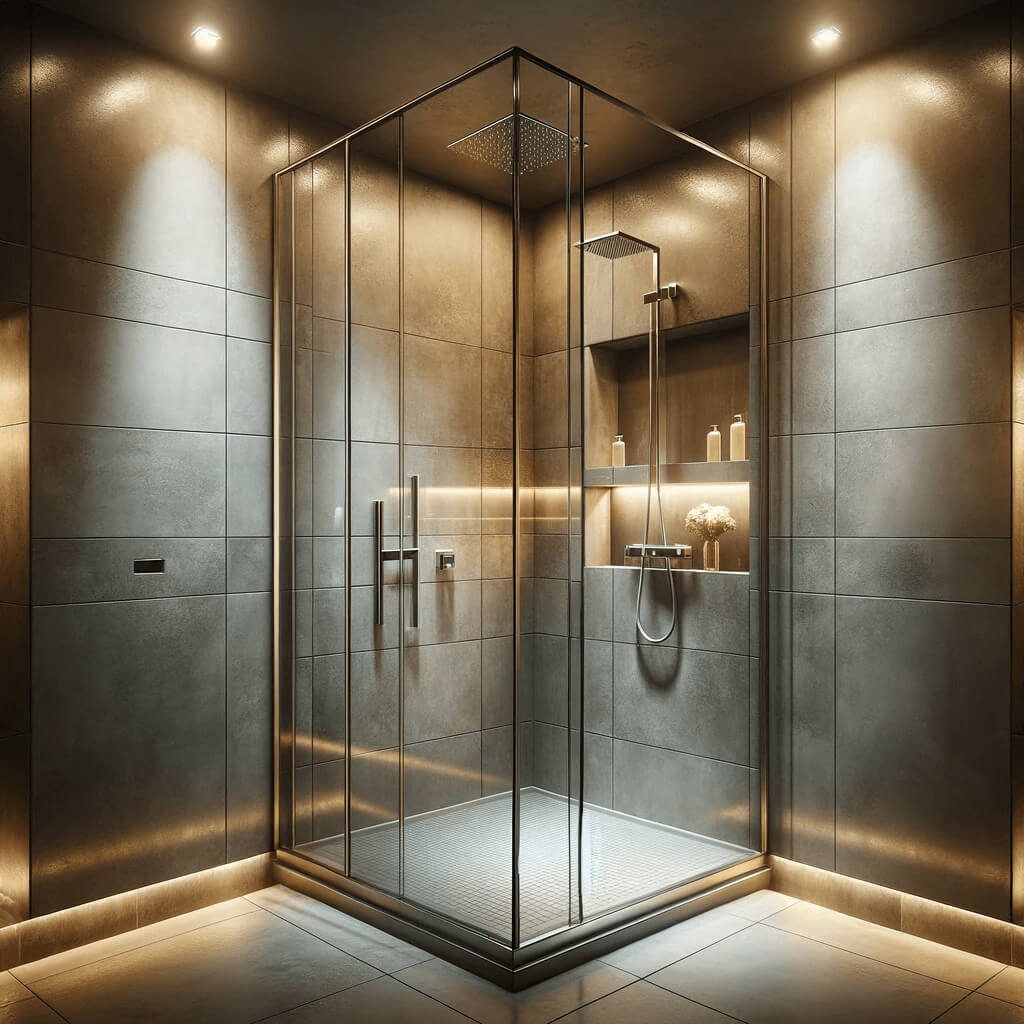
Square shower cabins are among the most popular and versatile solutions on the market as they work well in bathrooms of various sizes and layouts. Their main feature is their symmetrical shape, which facilitates installation in bathroom corners or along the wall, optimizing the use of available space. Cabins with hinged doors (like Mexen Pretoria), sliding doors (like Mexen Rio), and folding doors (like Mexen Lima) are available.
Square cabins are based on a frame structure, making them suitable for both newer and older bathrooms. Such a cabin is a good choice if you're looking for a universal, timeless, and simultaneously practical solution. Each of our cabins is made from the highest quality components, and the Crystal coating protects against limescale deposits and makes it easier to keep the glass clean.
Features of square shower cabins
- Sizes — square cabins are available in different sizes, allowing them to fit small, medium, and larger bathrooms. The most popular dimensions are 80 × 80 cm, 90 × 90 cm, and larger models 100 × 100 cm. Choosing the right size depends on the available space and individual user preferences.
- Tray or linear drain — square cabins can be installed with traditional trays or modern solutions like linear drains. Trays offer a clear separation of the shower area from the rest of the bathroom and are available in various depths, allowing for a choice between easier access and better water retention. On the other hand, the linear drain offers a more minimalist and modern look and is ideal for those who value simple and elegant lines, as well as for people with limited mobility.
| ✅Advantages | ⛔Disadvantages |
| Space-saving. | Limited space. |
| Versatility — fits many bathrooms. | |
| Easy installation. |
Rectangular shower cabin
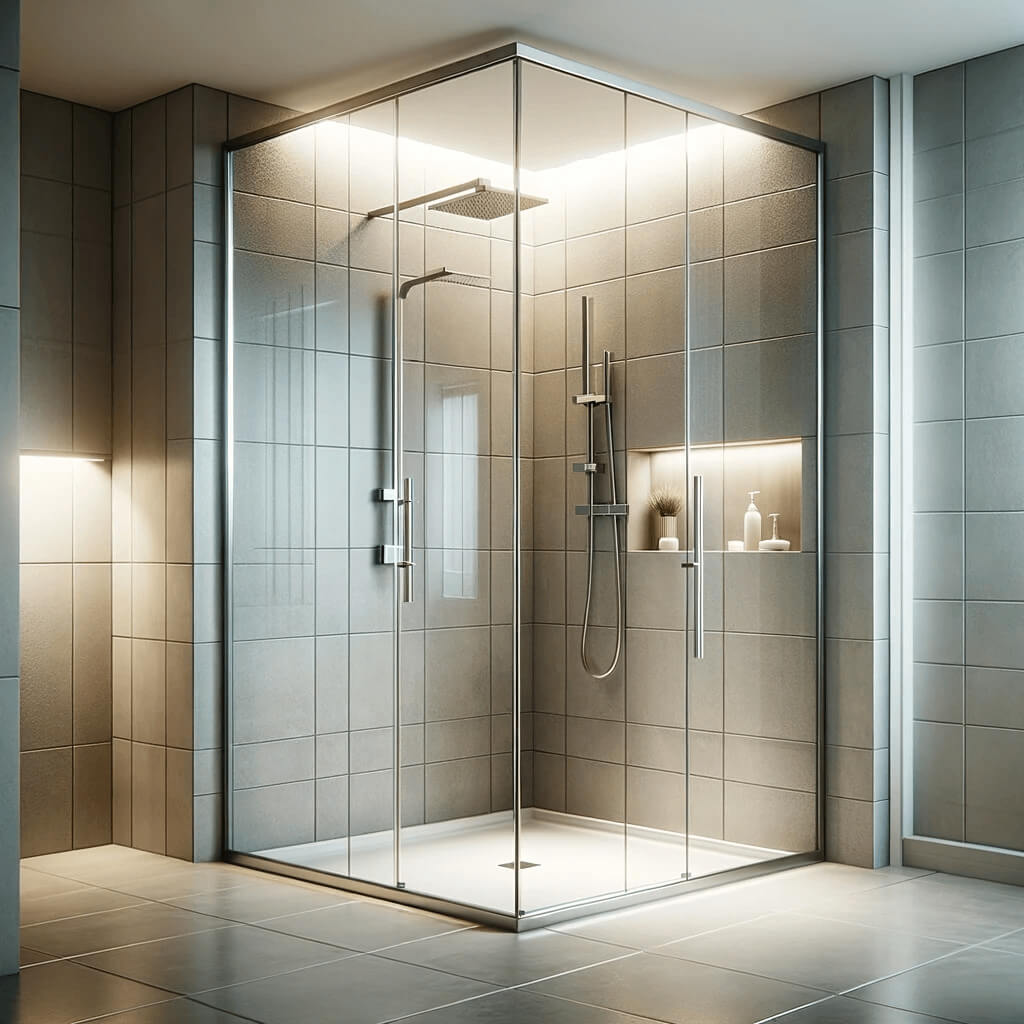
Rectangular shower cabins are an excellent solution for those who appreciate space and comfort during bathing. A rectangular cabin (such as Mexen Pretoria) is characterized by an elongated shape, making it an ideal choice for larger bathrooms, offering much more space inside than their square or semi-circular counterparts. This translates not only into greater freedom of movement for the user but also into the possibility of installing additional accessories (such as shower seats or shelves for cosmetics).
When browsing rectangular cabins, pay attention to the doors — they open in different ways. Models with hinged doors (e.g., Mexen Roma) and sliding doors (e.g., Mexen Rio) are available.
Undoubtedly, rectangular models are the best shower cabins for people who value space, as well as those who need additional amenities, such as a seat or handle.
Features of rectangular shower cabins
- Sizes — contrary to appearances, rectangular cabins can fit even in a small bathroom. They are available in a wide range of sizes, from relatively compact dimensions, such as 70 × 80 cm, to more spacious options, such as 140 × 100 cm. This makes it easy to tailor them to specific spatial requirements and user preferences.
- Tray or linear drain — like square cabins, rectangular cabins can be installed with traditional trays or a linear drain.
|
✅Advantages |
⛔Disadvantages |
| Larger internal space. | More space requirements. |
| Possibility to install additional accessories. | Requires careful planning. |
| Elegant and modern design. | |
| Ideal for people with limited mobility. |
Semi-circular shower cabin
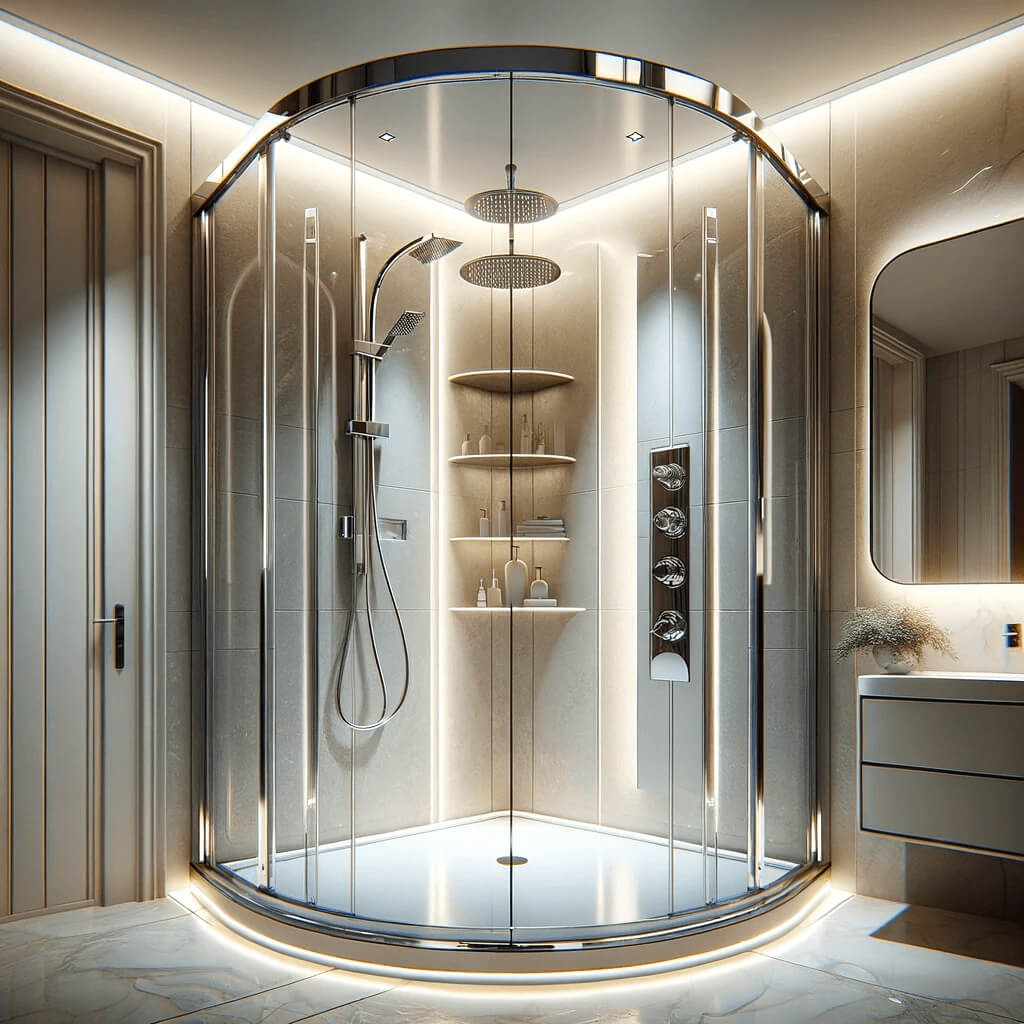
Shower cabins with a rounded front are a popular choice among those seeking space savings without sacrificing elegance and style. Their unique shape makes them an excellent solution for smaller bathrooms, where every centimeter of space matters. The rounded lines add modernity to the bathroom, while seamlessly integrating into the space, creating an impression of spaciousness.
In our offer, you can find elegant semi-circular cabins available in different colors. You can choose both the glass color (transparent, graphite, black, or striped glass) and the profile color (chrome, gold, black). This allows you to match the cabin to the style of practically any bathroom!
Features of semi-circular shower cabins
- Sizes — semi-circular cabins generally have standard dimensions, allowing easy installation in most bathroom designs. The most popular are cabins with a radius of 80 cm or 90 cm, although others are available, enabling adaptation to specific needs and spatial requirements.
- Tray or linear drain — like other types of cabins, semi-circular models can be equipped with both traditional trays and a linear drain.
When choosing a semi-circular cabin, it is worth considering both its advantages and potential limitations to ensure it meets the user's needs and preferences. Placing a seat, handle, or additional shelves for cosmetics in a semi-circular cabin might be harder, although not impossible.
| ✅Advantages | ⛔Disadvantages |
| Perfect for smaller bathrooms where every centimeter counts. | Limitation of space during bathing in the smallest models. |
| Elegant and modern look. | Fewer bathroom accessory choices that can be used in the cabin. |
| Easy to keep clean. | |
| Suit modern and more traditional bathrooms. |
Walk-in shower cabin
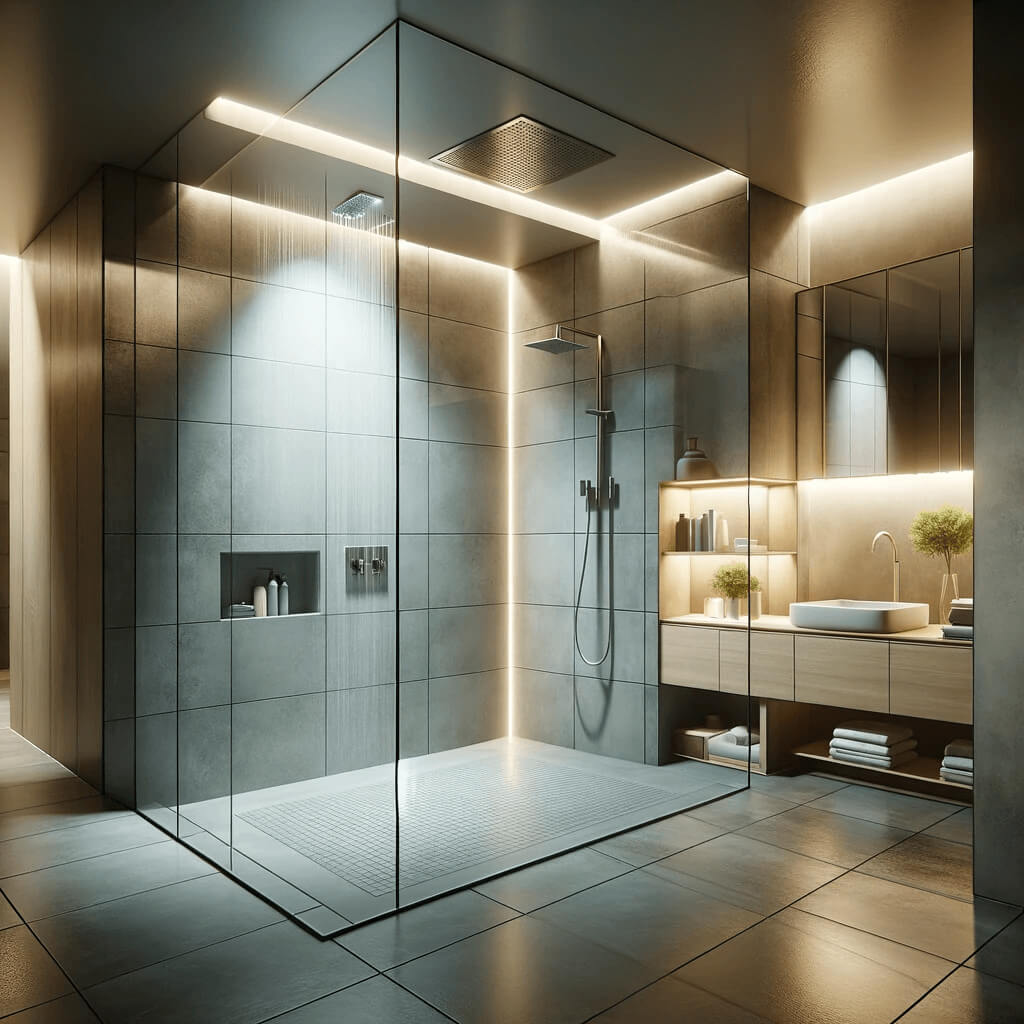
Walk-in shower cabins, also known as floor-level showers, are modern and elegant solutions gaining momentum in bathroom design. Their main feature is the lack of traditional doors and a low threshold, making the shower space easily accessible and visually enlarging the bathroom. This solution is not only visually appealing but also practical — especially for people with mobility issues.
Features of walk-in cabins
- Open access — characterized by open access, providing exceptional ease of use and a minimalist look.
- Minimalist design — simple lines and lack of unnecessary structural elements make these cabins fit perfectly into modern, spacious bathroom projects.
- Size — walk-in cabins often take up more space than traditional ones, offering more room inside.
| ✅Advantages | ⛔Disadvantages |
| The lack of doors makes entry and exit easy, which is particularly beneficial for people with limited mobility. | Careful planning is required for drainage to prevent water leaking outside the shower area. |
| Modern and elegant look that can optically enlarge the bathroom space. | It may require specialized installation and proper water insulation. |
| The lack of doors and fewer nooks and crannies makes cleaning easier. | The walk-in shower can feel cooler and less comfortable. |
| Possibility of using various arrangement solutions, including the installation of benches or shelves. |
What shower cabin for a small bathroom?
The shape of the cabin in a small bathroom is crucial. Ideally, place the cabin in a corner of the bathroom and use a semi-circular finish with chrome profiles and tempered glass. In small bathrooms, cabin doors can be chosen depending on the available space. In such a situation, it's worth opting for sliding doors, which take up significantly less space and can thus increase the usability comfort of a small bathroom.
Recommended models for small bathrooms:
- Square shower cabin — a square cabin with dimensions 70 × 70 cm or 80 × 80 cm with folding or sliding doors is a solution for small bathrooms that offers an ideal compromise between space-saving and user comfort. Among recommended square shower cabins, Mexen Rio and Mexen Lima can be highlighted.
- Rectangular shower cabin — if you've managed to secure a bit more space in a small bathroom, you can opt for a rectangular cabin with dimensions 70 × 80 cm or 70 × 90 cm. This will undoubtedly be the most comfortable solution available for small bathrooms. It's worth noting models like Mexen Pretoria and Mexen Roma.
- Semi-circular shower cabin — the best solution for bathrooms — especially the smallest ones. Among small yet still comfortable models, you can find Mexen Rio semi-circular shower cabin.
What makes a good shower cabin?
When choosing a shower cabin, you should not only consider the shape but also the aesthetics and quality of execution. In regions of Poland where water hardness is high, keeping the cabin clean is genuinely challenging. Therefore, it is worth ensuring that, besides being made of safe tempered glass, the walls also have an EasyClean coating that facilitates cleaning and, what will certainly be an additional advantage, is resistant to matting and corrosion. For those who wish to maintain greater privacy, it's worth paying attention to the glass color and opting for the "frosted" version.
Types of shower doors
Shower doors play a crucial role in shaping the appearance, functionality, and comfort of using a shower cabin. They can significantly influence the overall aesthetics of the bathroom, as well as how the space is perceived and used. Various types of shower doors are available on the market, each with its own set of advantages and characteristic features.
Sliding doors
Sliding doors for the shower cabin are a choice appreciated for both its functionality and aesthetics. They are ideal for use in smaller bathrooms because the sliding mechanism does not require additional space to open, unlike pivot doors that open outward.
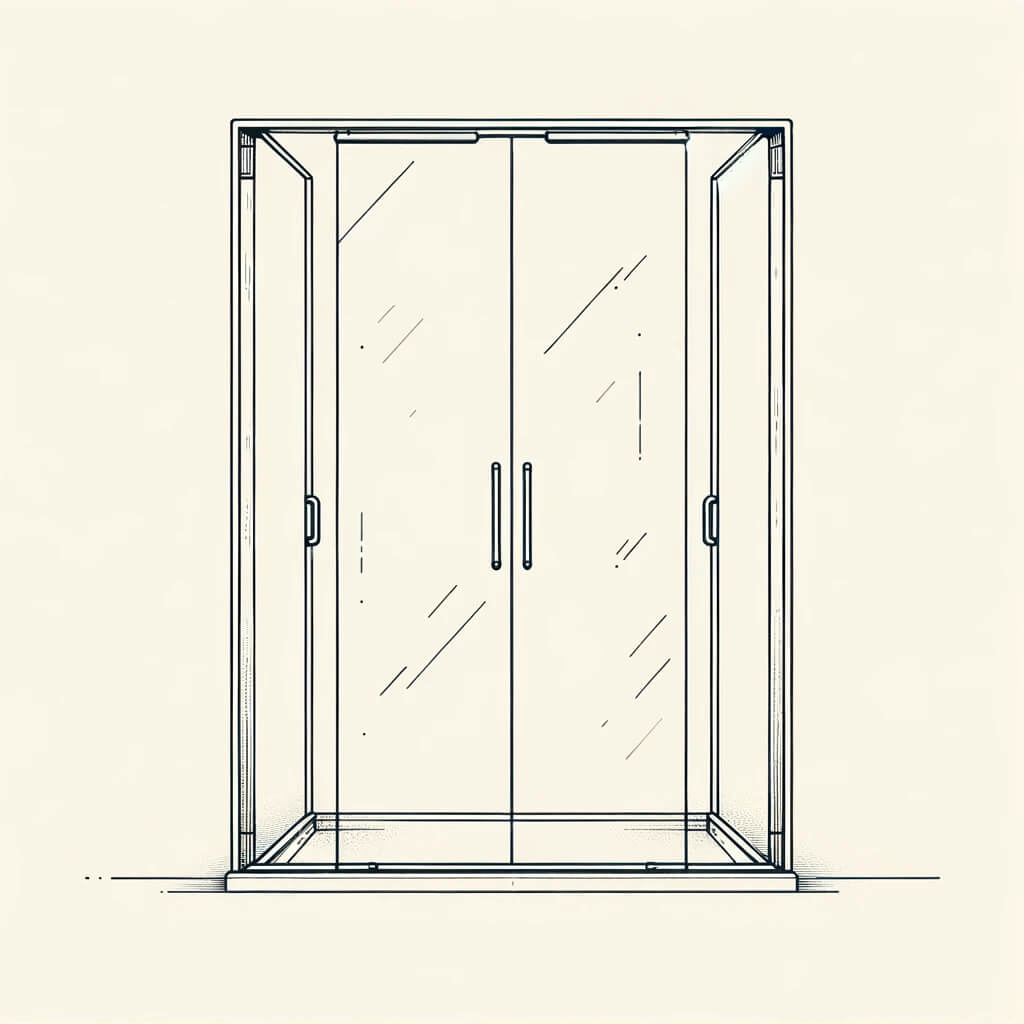
Sliding doors can consist of one or two panels that easily slide to the sides, providing easy access to the shower.
Features of sliding doors
- Sizes — sliding doors are available in various sizes, allowing adaptation to a wide range of shower cabins, from small to large solutions. Dimensions can be tailored to specific spatial needs, making them a versatile choice for many bathroom projects. Cabins with sliding doors are very popular on the market.
- Materials — the most popular materials used to produce sliding doors are tempered glass and aluminum. Tempered glass provides durability and safety while maintaining a light and spacious appearance.
| ✅Advantages | ⛔Disadvantages |
| Ideal for small bathrooms. | Water and soap can accumulate in the door tracks, requiring regular cleaning. |
| Wide entrance makes it easy to access the shower. | |
| Available in many styles, easy to match any bathroom. | |
| Using tempered glass ensures durability and safety. |
Pivot doors
Pivot doors for the shower cabin are an elegant and practical solution providing easy access to the shower space. They are characterized by the ability to open both inward and outward of the cabin, making them extremely functional in various bathroom layouts.
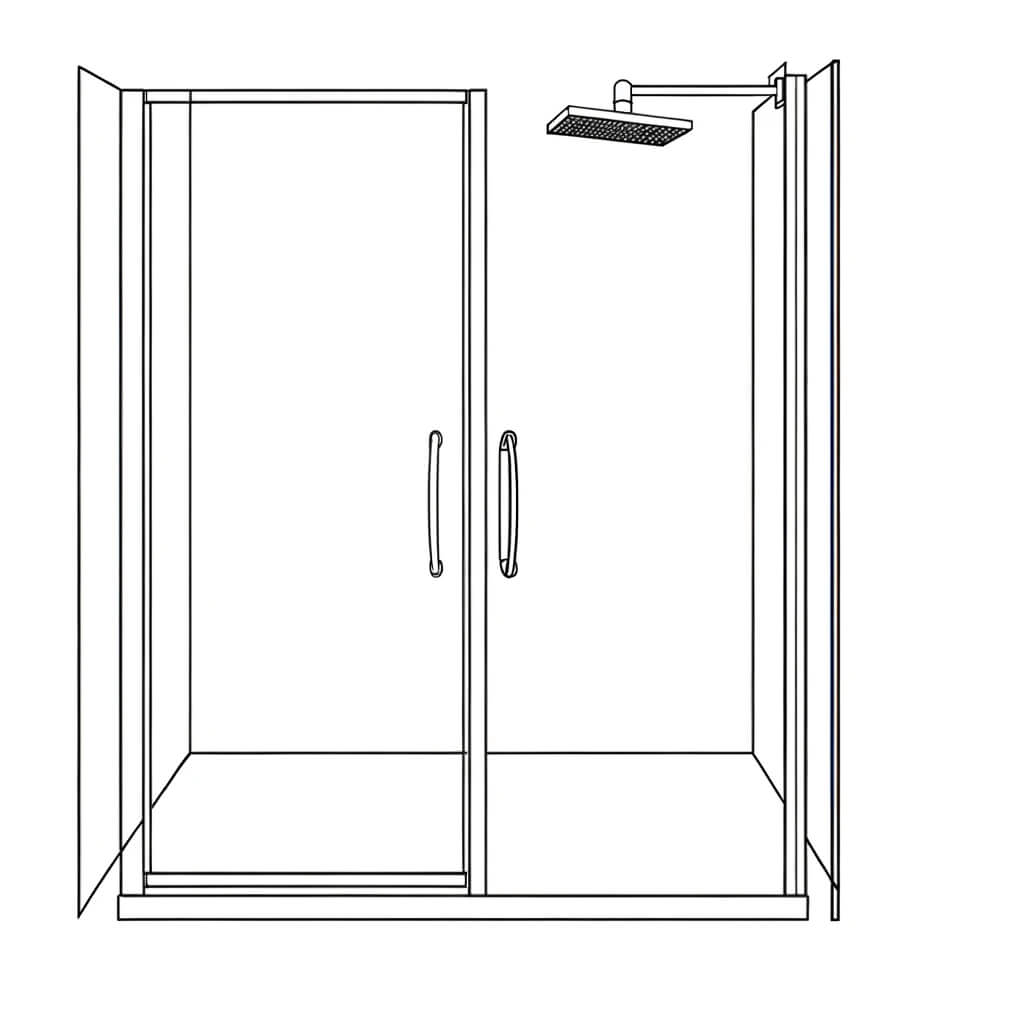
Their construction is based on hinges placed on one side of the door, allowing free opening in both directions.
Features of pivot doors
- Sizes — pivot doors are available in various sizes — suitable for a wide range of shower cabins. They can be used in both small and large cabins, offering flexibility in design.
- Materials — like sliding doors, the most commonly used materials for producing pivot doors are tempered glass and aluminum. Tempered glass provides safety and durability, while aluminum frames offer lightweight and corrosion resistance.
| ✅Advantages | ⛔Disadvantages |
| Opening in both directions increases functionality with different bathroom layouts. | Narrower entrance to the cabin. |
| Using tempered glass and sturdy hinges ensures long-lasting use. | |
| No bottom tracks make cleaning easier. |
Folding doors
Folding doors are innovative and space-efficient solutions for shower cabins. They are ideal for small bathrooms, where every square centimeter is valuable. Due to their unique design, the doors fold in the opening, minimizing the need for free space to open and close, making cabins equipped with them an excellent choice for tight spaces.
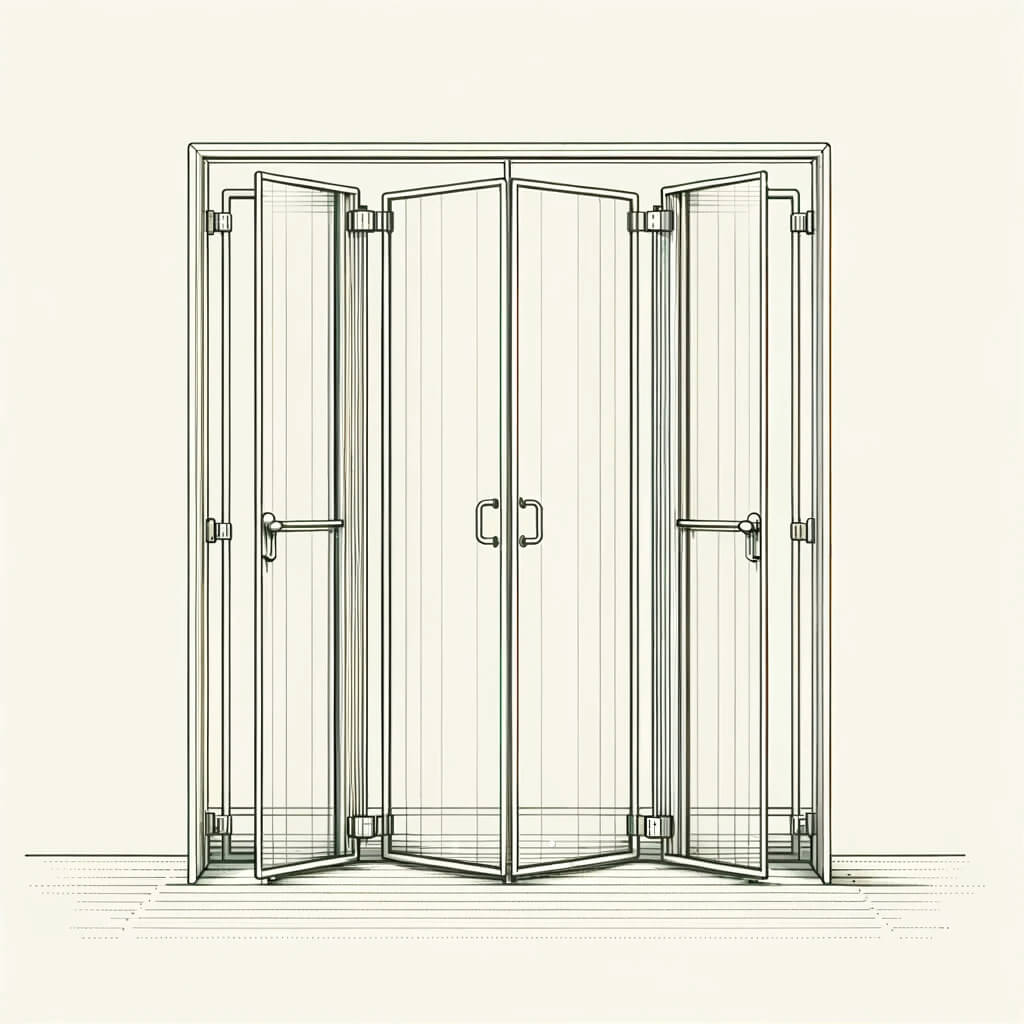
Features of folding doors
- Sizes — folding doors can be made to order. Their versatility makes them perfect for a wide range of bathroom projects, both in smaller and larger spaces.
- Materials — like other types of shower doors, folding doors are often made of tempered glass, ensuring safety and durability, and aluminum frames, offering lightweight and corrosion resistance. Tempered glass can also be customized in terms of finish, offering transparent, matte, or patterned options.
| ✅Advantages | ⛔Disadvantages |
| Ideal solutions for small bathrooms, minimizing the need for free space. | Regular maintenance may be required to ensure smooth operation. |
| Wide opening makes access and use easier. | Potentially less sealing compared to sliding or pivot doors. |
| Usually easier to install than other types of shower doors. | |
| Available in many styles and finishes, easy to match any bathroom decor. |
Choosing a shower tray for the cabin
Choosing the right shower tray is crucial in bathroom design, impacting the comfort of use, aesthetics, and functionality of the shower cabin. The tray not only provides the foundation for the shower but also ensures safe water drainage.
When buying a tray, pay attention to:
- Dimensions and shape — trays are available in various sizes and shapes. In our offer, you can find square trays, rectangular trays, and semi-circular trays. Custom, non-standard ones are also available, allowing optimal use of the available space.
- Material — trays are made from different materials, such as acrylic, ceramic, composites, natural stone, or high-quality steel. Each of these materials has its own advantages and disadvantages, affecting durability, ease of cleaning, appearance, and price.
- Height — trays can have low, medium, or high thresholds. Low trays provide easier access and a modern look, but may require more precise installation. Deep trays provide better water insulation, but may be less comfortable to use.
- Drain type — choose the type of drain that suits your needs — central, corner, or linear. The linear drain, increasingly chosen in modern bathrooms, offers an elegant solution and is easy to maintain.
Types of trays based on the material
Acrylic trays
Acrylic trays are a popular choice among homeowners and interior designers mainly due to their aesthetic appearance, functionality, and relatively affordable price. Made of acrylic, which is a type of plastic, these trays have a number of advantages that make them an attractive option for many bathrooms.
| ✅Advantages | ⛔Disadvantages |
| Provides greater comfort of use than materials such as ceramic or stone. | Some cleaning agents can damage the acrylic surface. |
| Smooth surface prevents the buildup of dirt and limescale. | |
| Modern look that fits every bathroom style. |
Ceramic trays
Ceramic trays, made from clay materials coated with glaze, are a popular choice in bathrooms worldwide due to their durability, aesthetics, and ease of maintenance. Ceramics as a material for tray production has a long history, combining traditional production methods with modern technologies, resulting in high-quality, diverse products.
| ✅Advantages | ⛔Disadvantages |
| Ceramics are resistant to scratches and abrasion, making these trays long-lasting. | Ceramic trays are much heavier than acrylic ones, which can hinder transport and installation. |
| The hard, smooth surface of ceramics facilitates maintaining cleanliness and hygiene. | Unlike acrylic, ceramics are cold to the touch. |
| This material is resistant to most cleaning agents, making it easy to maintain cleanliness. | Although ceramics are durable, they can crack under strong impacts. |
| Ceramics offer a timeless look that pairs well with various bathroom styles. | Ceramic trays can lose the water's heat faster. |
| The color of ceramics does not fade under sunlight or chemicals. | |
| Available in various finishes, allowing adaptation to any bathroom. |
Composite trays
Composite trays are appreciated for their exceptional durability and the possibility of customization to individual user needs. Their production involves combining resins with aggregates, creating a material with high resistance to loads, scratches, and chemicals. The surface of composite trays is usually smooth, ensuring ease of cleaning, but can also be textured, increasing safety through anti-slip properties.
Thanks to modern production technologies, composite trays offer a much wider range of aesthetic possibilities than traditional materials. They can mimic the appearance of natural stone, concrete, or even metal, allowing for unique bathroom character creation. Additionally, the possibility of making custom-sized trays is especially attractive for bathroom designs with unusual shapes or sizes.
| ✅Advantages | ⛔Disadvantages |
| Composite materials are very hard and resistant, ensuring long-term, impeccable appearance. | The quality and durability of composite materials often come with higher costs compared to standard solutions. |
| Smooth, non-porous surface facilitates hygiene maintenance. | Composite trays can be heavier than acrylic models, complicating installation. |
| Many models offer built-in anti-slip protection, increasing safety. | Avoid direct contact with very hot objects. |
| Available in various colors and textures, can mimic natural stone or other materials. | |
| Allows for perfect fit to non-standard bathroom designs. |
Stone trays
Stone trays are a luxury solution for those seeking not only functionality but also exceptional design in their bathroom. Made from natural stone, such as marble, granite, or travertine, or composites imitating natural stone, they offer a unique look and durability.
Trays made from natural stone are not only exceptionally durable but also resistant to moisture and mildew. Natural stone is a 100% ecological material.
| ✅Advantages | ⛔Disadvantages |
| Stone is highly resistant to scratches, abrasion, and other damage. | Natural stone is more expensive than most other materials. |
| Natural stone is easy to clean and resistant to most cleaning agents. | Stone trays are heavy, which can complicate transport and installation. |
| Stone is naturally resistant to moisture and mildew. | Stone is cold to the touch, which may be uncomfortable, especially on colder days. |
| Stone trays can increase the value and attractiveness of a house on the real estate market. | To prevent water absorption and staining, stone often requires regular sealing. |
Steel trays
Steel trays, made of enameled steel, are valued solutions for those seeking durable and functional options for their bathrooms. They combine the durability of steel with aesthetic enamel finishes, making them a popular choice in many homes.
Enameled steel is an extremely durable and damage-resistant material, making trays made from it long-lasting. Their resistance to chemicals allows for using various cleaning agents without fear of damaging the surface.
| ✅Advantages | ⛔Disadvantages |
| Enameled steel is very durable, resistant to scratches, bumps, and other mechanical damages. | Like stone, steel is cold to the touch. |
| Enamel has a smooth surface that makes it easy to maintain cleanliness and hygiene. | Although enamel is durable, very heavy impacts can cause chipping. |
| Enamel is resistant to most cleaning agents, facilitating hygiene maintenance. | Color and pattern choices are more limited than with other materials. |
| Steel trays can serve many years without losing appearance or functionality. | Steel quickly takes on the surrounding temperature, which can affect comfort. |
Types of trays based on shape
Choosing the right tray is not only limited to the material it's made from but also its shape. The shape of the tray is critical not only from an aesthetic point of view but also functional, affecting how the bathroom space will be organized.
Square tray
Square trays are among the most universal solutions for bathrooms, combining functionality with simplicity of form. Their classic shape makes them suitable for almost any type and style of bathroom, from traditional to modern. Thanks to their symmetrical dimensions, square trays can be easily placed in the corners of bathrooms, which is an efficient way to optimize space.
A few recommended square trays include:
- Mexen Flat square tray
- Mexen Rio square tray
- Mexen Hugo square tray
- Mexen Stone+ square tray
| ✅Advantages | ⛔Disadvantages |
| They suit most bathrooms regardless of their style and size. | Limited space: May be less comfortable for tall people or those who prefer more space under the shower. |
| Efficient space usage: Ideal for installation in corners, saving bathroom space. | Standard solution: May be perceived as less original than uniquely shaped trays. |
| Ease of installation: Symmetrical shape facilitates installation and fitting with existing shower installations. | Choice of shower cabins: May limit choice to cabins designed specifically for square trays. |
| Availability: Widely available in many stores and easy to find appropriate accessories. | |
| Multifunctionality: Can be used in small and large bathrooms and various spatial configurations. |
Rectangular tray
Rectangular trays are a choice for those who value space and comfort during bathing. Thanks to their elongated dimensions, these trays offer more room, which is especially appreciated in larger bathrooms or by those preferring more spacious conditions during showers.
We particularly recommend the following models of rectangular trays:
- Mexen Flat rectangular tray
- Mexen Hugo rectangular tray
- Mexen Toro rectangular tray
- Mexen Stone+ rectangular composite tray
| ✅Advantages | ⛔Disadvantages |
| Larger internal space: Provides more room for bathing and freedom of movement. | Requires more space: May not fit in small bathrooms. |
| Ideal for open showers: The width of the tray allows for the installation of open showers. | Higher cost: Larger dimensions may mean a higher price than smaller trays. |
| Can be installed both against the wall and in the corner. | Weight: Larger trays may be heavier and more challenging to install. |
| Luxurious appearance: A large tray can add a sense of luxury and spaciousness to a bathroom. | Transportation constraints: Larger sizes may complicate transportation to the installation site. |
| Availability in many materials: Like other types of trays, available in various finishes and materials. |
Semi-circular tray
Semi-circular trays, with their elegant, rounded front, are perfect solutions for modern bathrooms, where both aesthetics and functionality matter. Their unique shape not only saves space but also adds lightness and modern character to the bathroom.
| ✅Advantages | ⛔Disadvantages |
| Space-saving: Ideal for smaller bathrooms, where every centimeter matters. | Limited internal space: May offer less room for bathing than rectangular trays. |
| Aesthetic appearance: A rounded front adds modernity and elegance to the bathroom. | Limited installation options: Best installed in corners. |
| Safety: Lack of sharp edges reduces the risk of injury. | Matching cabin: Requires specifically matched shower cabins. |
| Ease of cleaning: Fewer corners and crannies make it easier to maintain cleanliness. | Choice of sizes: May be smaller than square or rectangular trays. |
| Many finish options: Available in various materials, including acrylic, ceramic, and stone. |
Choosing a siphon for the shower tray
Selecting the appropriate siphon for a shower tray is crucial for ensuring proper water drainage and maintaining hygiene and comfort in the bathroom.
The siphon, an element of the plumbing system, also prevents unpleasant odors from the sewer from entering the room. To make the best choice, it's important to know the types of siphons available on the market and the factors to consider when selecting them.
Pay attention to:
- Flow rate — choose a siphon with a flow rate adequate for the amount of water that may accumulate during a shower. This will ensure quick water drainage and prevent it from pooling in the tray.
- Installation height — check the space you have under the tray. Some siphons require more installation space than others. Low-profile siphons are ideal for floor-level tray installations.
- Cleaning and maintenance — choose models that allow easy cleaning and access to the waste trap to help maintain hygiene and prevent clogs.
- Compatibility with the tray — ensure the chosen siphon is compatible with your tray model in terms of drain size and type.
Types of shower tray siphons
- Siphon with vertical outlet — ideal for installations where the tray is close to the floor, and space is limited. The outlet is directed straight down, requiring floor penetration.
- Siphon with horizontal outlet — the most commonly used type of siphon, directing water to the sewer through the wall, without floor penetration. It's easy to install and fits most installations.
- Low-profile siphon — specially designed for floor-level tray installations. It features a low installation height — often used in modern bathrooms.
- Siphon with linear drain — increasingly popular in modern bathroom designs. It consists of a long, narrow drain that can be placed at the edge of the tray or directly on the floor, creating a seamless shower. It offers an elegant look and high flow rate. Linear models are divided into wall linear drains and floor linear drains.
Each siphon has its benefits and specific uses that need to be matched to individual needs and bathroom specifications. Choosing the right model will ensure not only aesthetics but also functionality and ease of daily use.
FAQ
How to choose a shower cabin?
A shower cabin should be matched to our bathroom (including available space and room layout) as well as our needs and preferences. You can choose between rectangular, square, and semi-circular cabins (the latter being suitable for smaller spaces). It's also important to choose the right type of door — options include pivot, sliding, and folding doors. Walk-in showers, which have no doors at all, are also becoming fashionable.
What does it mean that a cabin is wall-mounted?
It's a shower cabin that uses your bathroom walls. You can build a large rectangular or square shower cabin using one bathroom wall — with 3 glass walls, while a corner cabin, placed in the bathroom corner, would always fit a small bathroom.
What does it mean that a shower cabin is walk-in type?
A walk-in shower cabin is one that usually does not have a traditional tray. This type is most commonly used in modern bathrooms.
What to consider when choosing a shower cabin?
Start by examining your bathroom. Should it be a wall-mounted cabin? That’s one that utilizes the bathroom walls. Or is a free-standing one? Depending on the bathroom size, you can choose a model consisting of 3 panes of glass, whereas a corner cabin, using two walls, would fit a small bathroom.
What shower cabin is easiest to clean?
During purchase, focus primarily on whether the cabin is made of safe tempered glass — ideally, of an 8-millimeter thickness. Then pay attention to the coating covering the glass. An EasyClean coating has hydrophobic properties — water droplets slide down the smooth surface of the glass without leaving deposits, significantly easing cleaning and increasing corrosion protection.
What shower cabin is most comfortable?
Without a doubt, the walk-in shower cabin is the most comfortable solution available on the market. This type usually doesn't have a traditional tray. This solution features a flat floor, often at the same level as the rest of the bathroom, providing easy access and a modern appearance. The floor in this part of the bathroom is usually equipped with an appropriate slope directing water towards the drain. This design allows easier entry and exit, particularly useful for individuals with limited mobility.
How much will I pay for a good shower cabin?
The price of a shower cabin depends on many factors: size, the type of doors used, and the number of walls. Prices start from 500 zloty.
Types of shower cabins
Shower cabins can be categorized by:
- Shape: semi-circular shower cabins, square shower cabins, rectangular shower cabins, and walk-in cabins.
- Cabin door type: sliding doors, pivot doors, folding doors.


















